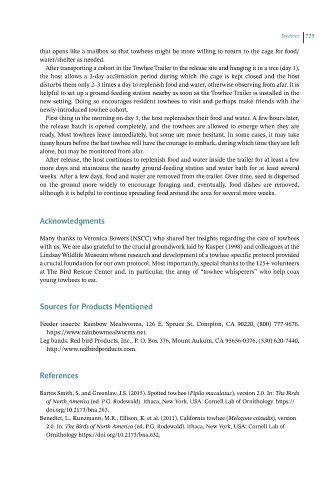Page 727 - Hand rearing birds second
P. 727
Towhees 729
that opens like a mailbox so that towhees might be more willing to return to the cage for food/
water/shelter as needed.
After transporting a cohort in the Towhee Trailer to the release site and hanging it in a tree (day 1),
the host allows a 3‐day acclimation period during which the cage is kept closed and the host
disturbs them only 2–3 times a day to replenish food and water, otherwise observing from afar. It is
helpful to set up a ground‐feeding station nearby as soon as the Towhee Trailer is installed in the
new setting. Doing so encourages resident towhees to visit and perhaps make friends with the
newly‐introduced towhee cohort.
First thing in the morning on day 3, the host replenishes their food and water. A few hours later,
the release hatch is opened completely, and the towhees are allowed to emerge when they are
ready. Most towhees leave immediately, but some are more hesitant. In some cases, it may take
many hours before the last towhee will have the courage to embark, during which time they are left
alone, but may be monitored from afar.
After release, the host continues to replenish food and water inside the trailer for at least a few
more days and maintains the nearby ground‐feeding station and water bath for at least several
weeks. After a few days, food and water are removed from the trailer. Over time, seed is dispersed
on the ground more widely to encourage foraging and, eventually, food dishes are removed,
although it is helpful to continue spreading food around the area for several more weeks.
Acknowledgments
Many thanks to Veronica Bowers (NSCC) who shared her insights regarding the care of towhees
with us. We are also grateful to the crucial groundwork laid by Kasper (1998) and colleagues at the
Lindsay Wildlife Museum whose research and development of a towhee‐specific protocol provided
a crucial foundation for our own protocol. Most importantly, special thanks to the 125+ volunteers
at The Bird Rescue Center and, in particular, the army of “towhee whisperers” who help coax
young towhees to eat.
Sources for Products Mentioned
Feeder insects: Rainbow Mealworms, 126 E. Spruce St, Compton, CA 90220, (800) 777‐9676.
https://www.rainbowmealworms.net.
Leg bands: Red bird Products, Inc., P. O. Box 376, Mount Aukum, CA 95656‐0376, (530) 620‐7440,
http://www.redbirdproducts.com.
References
Bartos Smith, S. and Greenlaw, J.S. (2015). Spotted towhee (Pipilo maculatus), version 2.0. In: The Birds
of North America (ed. P.G. Rodewald). Ithaca, New York, USA: Cornell Lab of Ornithology. https://
doi.org/10.2173/bna.263.
Benedict, L., Kunzmann, M.R., Ellison, K. et al. (2011). California towhee (Melozone crissalis), version
2.0. In: The Birds of North America (ed. P.G. Rodewald). Ithaca, New York, USA: Cornell Lab of
Ornithology https://doi.org/10.2173/bna.632.

